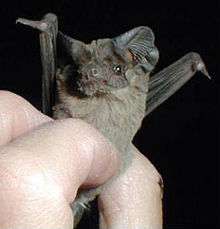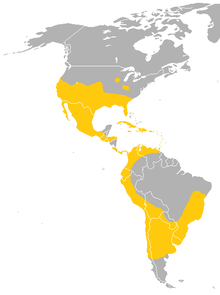Mexican free-tailed bat
| Mexican free-tailed bat Tadarida brasiliensis | |
|---|---|
 | |
| Scientific classification | |
| Kingdom: | Animalia |
| Phylum: | Chordata |
| Class: | Mammalia |
| Order: | Chiroptera |
| Family: | Molossidae |
| Genus: | Tadarida |
| Species: | T. brasiliensis |
| Binomial name | |
| Tadarida brasiliensis (I. Geoffroy, 1824) | |
| Subspecies | |
| |
 | |
| Range of the Mexican free-tailed bat | |
The Mexican free-tailed bat (Tadarida brasiliensis), also known as the Brazilian free-tailed bat, is a medium-sized bat that is native to the Americas, regarded as one of the most abundant mammals in North America. Its proclivity towards roosting in huge numbers at relatively few locations makes it vulnerable to habitat destruction in spite of its abundance. The bat is considered a species of special concern in California as a result of declining populations.
It has been claimed to have the fastest horizontal speed of any animal, reaching top ground speeds of over 160 km/h; its actual air speed has not been measured.
Taxonomy
Molecular sequence data indicates T. brasiliensis's closest relatives are Chaerephon jobimena of Madagascar and Tadarida aegyptiaca of Africa and south Asia; the latter two are sister species. These three species form a clade believed to be about 9.8 million years old.[1]
Physical description
Mexican free-tailed bats are on average 9 cm (3.5 in) in length and weigh approximately 12.3 g (0.43 oz). The average wingspan is 28 cm (11 in).[2] Their tail is almost half their total length and stretches beyond the uropatagium, giving them the name "free-tailed" bats. Their ears are relatively close behind the muzzle and eyes; they are wide and set apart to help them find prey using echolocation. The muzzle is condensed, with wrinkled upper lips. The wings are elongated and narrow with pointed tips, making them well-equipped for quick, straight flight patterns. Their fur color ranges from dark brown to gray.
Range and ecology

The Mexican free-tailed bat ranges from the southern half of the continental United States through most of Mexico, and through most of Central America into South America. The range of the Mexican free-tailed bat in South America is less understood where it lives in the eastern Brazilian highlands and coast, the northeastern Andes and the coast of Peru and northern Chile.[3] It is absent in much of the Amazon rainforest. The bat is also found in the Caribbean, and is native to all of the Greater Antilles and 11 of the Lesser Antilles.[4] The largest known colony is found at Bracken Cave, north of San Antonio, Texas, with nearly 20 million bats; research indicates the bats from this colony congregate in huge numbers at altitudes between 180 and 1,000 m (590 and 3,280 ft), and even as high as 3,000 m (9,800 ft).
Habitat
Mexican free-tailed bats roost primarily in caves. However, they will also roost in buildings of any type as long as they have access to openings and dark recesses in ceilings or walls.[3] The bats can make roosting sites of buildings regardless of "age, height, architecture, construction materials, occupancy by humans and compass orientation".[3] Caves, on the other hand, need to have enough wall and ceiling space to fit millions of bats.[3] Before buildings, free-tailed bats in the southeastern United States probably roosted in the hollows of trees such as red mangrove, black mangrove, white mangrove and cypress. However, most bats in Florida seem to prefer buildings and other man-made structures over natural roosts.[3] Caves in Florida tend to be occupied mostly by the southeastern myotis. Caves in Florida tend to have pools of water on the floor and the free-tailed bats do not need as much relative humidity as the southeastern myotis.[3]
Migration

Mexican free-tailed bats in southeastern Nevada, southwestern Utah, western Arizona and southeastern California come together to migrate southwest to southern California and Baja California.[3] Bats in southeastern Utah, southwestern Colorado, western New Mexico and eastern Arizona travel though western edge of the Sierra Madre Oriental into Jalisco, Sinaloa and Sonora. Some bats that summer in Kansas, Oklahoma, eastern New Mexico and Texas will migrate southward to southern Texas[5] and Mexico.[3] Some bat populations in other areas of North America do not migrate, but are residents and may make seasonal changes in roost sites.[3]

In Austin, Texas, a colony of Mexican free-tailed bats summers (they winter in Mexico) under the Congress Avenue Bridge ten blocks south of the Texas State Capitol. It is the largest urban colony in North America, with an estimated 1,500,000 bats.[6] Each night they eat 10,000 to 30,000 lb (4,500 to 13,600 kg) of insects. Each year they attract 100,000 tourists who come to watch them. In Houston, Texas, a colony is living under the Waugh Street Bridge over Buffalo Bayou. It is the home to 250,000 bats and also attracts viewers. The Mexican free-tailed bat is the official "flying mammal" of the state of Texas.[7]
Bats ranging eastward from East Texas do not migrate, but local shifts in roost usage often occur seasonally.[3] Also, a regional population that ranges from Oregon to California, has a year-round residence.
Diet

Mexican free-tailed bats are primarily insectivores. They hunt their prey using echolocation. The bats eat moths, beetles, dragonflies, flies, true bugs, wasps, and ants. Bats usually catch flying prey in flight.[8] Large numbers of Mexican free-tailed bats fly hundreds of meters above the ground in Texas to feed on migrating insects.[9] The consumption of insects by these bats can be quite significant.[10][11]
Additionally, Mexican free-tailed bats are also efficient pollinators.[11] Their pollination of sugarcane as well as their consumption of insects that damage sugar cane may be among the reasons why Bacardi rum features the Mexican free-tailed bat as its icon. Bacardi Ltd. themselves attribute the use of the bat in the logo to, "... Don Facundo’s wife, Amalia, who suggested using a bat for the company logo. It was an insightful choice, because according to Cuban and Spanish lore, bats symbolize good health, good fortune and family unity."[12]
Health and mortality
One individual bat was recorded to have lived eight years, based on dentition.[13] Predators of the bat include large birds such as red-tailed hawk, American kestrels, great horned owls, barn owls, and Mississippi kites.[3][14] Mammal predators include Virginia opossums, striped skunks, and raccoons.[3] Snakes such as eastern coachwhips and eastern coral snakes may also prey on them, but at a lesser extent. Certain types of beetles prey on neonate and juvenile bats that have fallen to the ground.[3] This species seems to have a low incidence of rabies, at least in the United States.[3] They do, however, contain certain pesticides.[3]
Behavior

Mexican free-tailed bats are nocturnal foragers and begin feeding after dusk. They travel 50 km in a quick, direct flight pattern to feed. This species flies the highest among bats, at altitudes around 3300 m.[15] Bats appears to be most active in late morning and afternoon between June and September.[16] Free-tailed bats are more active in warm weather.[17]
The species has been measured at a ground speed of 160 kilometres per hour (99 mph), measured by an aircraft tracking device.[18] The measurement methodology did not simultaneously record wind speed and ground speed, so the observations could have been affected by strong local gusts, and the bat's maximum air speed remains uncertain.[19]
Echolocation
Mexican free-tailed bats use echolocation for navigation and detecting prey. Traveling calls are of a brief but constant frequency. However, they switch modulated frequency calls between 40 and 75 kHz if they detect something.[20] Typically, the frequency range of their echolocation is between 49 and 70 kHz, but can be between 25 and 40 kHz if something crosses their path while in flight.[20]
On 6 November 2014, Aaron Corcoran, a biologist at Wake Forest University, North Carolina, reported online in Science that he and his team had detected Mexican free-tailed bats emitting ultrasonic vocalizations which had the effect of jamming the echolocation calls of a rival bat species hunting moths. The ‘jamming’ call led to an increased chance of the rival missing its prey, which the Mexican free-tailed bat was then able to eat itself. Earlier researchers had discovered some 15 types of social calls made by Mexican free-tailed bats and reported that they could adjust their calls to avoid interfering with others in range of their calls.[21][22]
Mating and reproduction
_-_Cartwright_Cave_-_March_2006_-_2.jpg)
During the breeding season, females aggregate into maternity roosts. The size of these roosts depends on the environment, with caves having the larger roosts. Mating can occur in an aggressive or passive form. In the aggressive form, the male controls the female's movements, keeping her away from the other bats in the roost.[23] He also tends to vocalize when mating. During passive copulation, the males simply flies to a female in her roost and quietly mounts her with no resistance. This species is a promiscuous breeder and both sexes copulate with multiple partners.[23] Females become sexually mature at about 9 months, while males take even longer, at two years. Females enter estrus once a year, which typically lasts five weeks in the spring. The gestation period of the bat lasts 11–12 weeks, with only one young being born. A number of pups are left in "creches", while their mothers roost elsewhere. The female uses vocalizations and scent to identify her pup. The mother imprints her scent on the young early on.[24] However, young try to steal a suckle from any female that passes through the cluster. A mother will nurse her young daily, and by 4–7 weeks old they are full grown, fully weaned, and independent.[25]
Protection
Though abundant and widespread, some local populations have prompted protection and conservation efforts. For instance, during the spring and summer, one of the largest Mexican free-tailed bat populations inhabits Cueva de la Boca, a cave near Monterrey, Mexico. In 2006, the Mexican environmental conservation NGO, Pronatura Noreste, purchased the property. Because of a reduction of more than 95% of the original 20 million bat population, as a result of vandalism, pollution, and uncontrolled tourism, the organization decided to buy the property to place it under conservation. Other species of high ecological value that inhabit the cavern are also being protected.
See also
- Bat bomb, an experimental incendiary weapon that used Mexican free-tailed bats as a dispersal mechanism
References
- ↑ Lamb, J. M.; Ralph, T. M. C.; Naidoo, T.; Taylor, P. J.; Ratrimomanarivo, F.; Stanley, W. T.; Goodman, S. M. (June 2011). "Toward a Molecular Phylogeny for the Molossidae (Chiroptera) of the Afro-Malagasy Region". Acta Chiropterologica. 13 (1): 1–16. doi:10.3161/150811011X578589.
- ↑ "Animal Diversity Web: Tadarida brasiliensis". Retrieved 2016-11-10.
- 1 2 3 4 5 6 7 8 9 10 11 12 13 14 15 Wilkins, K. (1989). "Tadarida brasiliensis". Mammalian Species , 331: 1-10.
- ↑ Baker, R. J., Genoways, H. H. 1978. Zoogeography of Antillean bats. In. Zoogeography in the Caribbean, ed. F. B. Gill pp. 53-97. Philadelphia: Acad
- ↑ Glass BP (1982) Seasonal movements of Mexican free- tail bats Tadarida brasiliensis mextcana banded in the Great Plains. Southwestern Nat., 27:127-133.
- ↑ "Bat Conservation International page on the Congress Avenue Bridge Bat Colony".
- ↑ "Texas State Symbols, Texas State Library and Archives Commission".
- ↑ McWilliams, L. 2005. Variation in diet of the Mexican free-tailed bat (Tadarida brasiliensis mexicana). Journal of Mammalogy, 86/3: 599-605.
- ↑ Gary F. McCracken, Erin H. Gillam, John K. Westbrook, Ya-Fu Lee, Michael L. Jensen and Ben B. Balsley (2008) "Brazilian free-tailed bats (Tadarida brasiliensis: Molossidae, Chiroptera) at high altitude: links to migratory insect populations", Integrative and Comparative Biology 48(1):107-118.
- ↑ Do Bats Control Mosquitoes?
- 1 2 Animal Fact Sheet: Mexican Free-Tailed Bat, Desert Museum
- ↑ Bacardi Ltd. Official Web Site – The Early Years
- ↑ Gannon, M., A. Kurta, A. Rodriquez-Duran, M. Willig. 2005. Bats of Puerto Rico. Jamaica: The University of the West Indies Press.
- ↑ Mikula, P.; Morelli, F.; Lučan, R. K.; Jones, D. N.; Tryjanowski, P. (2016). "Bats as prey of diurnal birds: a global perspective". Mammal Review. doi:10.1111/mam.12060.
- ↑ Williams, T., L. Ireland, J. Williams. 1973. High altitude flights of the free-tailed bat, Tadarida brasiliensis, observed with radar. Journal of Mammalogy, 54/4: 807-821.
- ↑ Svoboda, P., J. Choate. 1987. Natural history of the Brazilian free-tailed bat in the San Luis Valley of Colorado. Journal of Mammalogy, 68/2: 224-234.
- ↑ Allen, L., A. Turmelle, M. Mendonca, K. Navara, T. Kunz, G. McCracken. 2009. Roosting ecology and variation in adaptive and innate immune system function in the Brazilian free-tailed bat (Tadarida brasiliensis). Journal of Comparative Physiology, 179: 315–323.
- ↑ McCracken, Gary F.; Safi, Kamran; Kunz, Thomas H.; Dechmann, Dina K. N.; Swartz, Sharon M.; Wikelski, Martin (9 November 2016). "Airplane tracking documents the fastest flight speeds recorded for bats". Royal Society Open Science. doi:10.1098/rsos.160398.
- ↑ Photopoulos, Julianna (9 November 2016). "Speedy bat flies at 160km/h, smashing bird speed record". New Scientist. Retrieved 11 November 2016.
But not everyone is convinced. Graham Taylor at the University of Oxford says that errors in estimating bat speed by measuring the distance moved between successive positions could be huge. “So I think it would be premature to knock birds off their pedestal as nature's fastest fliers just yet,” he says."These bats are indeed flying very fast at times, but this is based on their ground speed," says Anders Hedenström at the University of Lund in Sweden. "Since they did not measure winds at the place and time where the bats are flying, one can therefore not exclude that the top speeds are not bats flying in a gust."
- 1 2 Gillam, E., G. McCracken. 2007. Variability in the echolocation of Tadarida brasiliensis: effects. Animal Behavior, 74: 277-286.
- ↑ Morell, Virginia (6 November 2014). "Holy blocked bat signal! Bats jam each other's calls". new.sciencemag.org. Retrieved 8 November 2014.
- ↑ Hogenboom, Melissa (7 November 2014). "Bats sabotage rivals' senses with sound in food race". BBC News. Retrieved 8 November 2014.
- 1 2 Keeley, A., B. Keeley. 2004. The Mating System of Tadarida brasiliensis (Chiroptera: Molossidae) in a Large Highway Bridge Colony. Journal of Mammalogy, 85/1: 113-1.
- ↑ Loughry, W., G. McCracken. 1991. Factors influencing female-pup scent recognition in Mexican free-tailed bats. Journal of Mammalogy, 72/3: 624-626.
- ↑ Kunz, T., S. Robson. 1995. Postnatal growth and development in the Mexican free-tailed bat (Tadarida brasiliensis mexicana): birth size, growth rates, and age estimation. Journal of Mammalogy, 76/3: 769-783.
Sources
- Barquez, R.; Diaz, M.; Gonzalez, E.; Rodriguez, A.; Incháustegui, S. & Arroyo-Cabrales, J. (2008). "Tadarida brasiliensis". IUCN Red List of Threatened Species. Version 2008. International Union for Conservation of Nature. Retrieved 4 March 2009.
- "Tadarida brasiliensis". Integrated Taxonomic Information System. Retrieved 23 March 2006.
External links
| Wikimedia Commons has media related to Tadarida brasiliensis. |
| Wikispecies has information related to: Tadarida brasiliensis |
- ARKive – images and movies of the Brazilian free-tailed bat (Tadarida brasiliensis)
- Untamed Science interview with a bat specialist at the Congress Street Bridge Colony
- Bat Conservation International website
- Mexican Bats Find Cross-Border Benefactors (Washington Post)
- Pronatura Noreste Announces the Purchase of Cueva de la Boca
- Bat Conservation International webpage about Mexican free-tailed bats
- Animal Diversity – Tadarida brasiliensis
